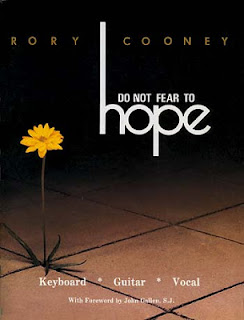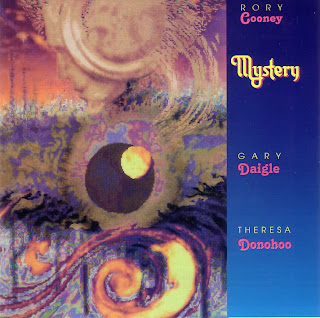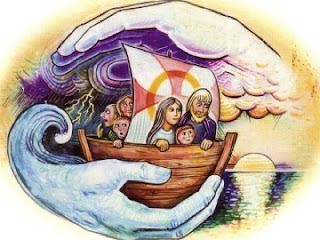While he was praying his face changed in appearanceIt struck me Sunday, listening to the gospel for the third or fourth time, that there might be more to the story of why Moses and Elijah are in the picture with Jesus on Mount Tabor at the transfiguration. The usual explanation goes along lines of “the fullness of the law and the prophets.” Moses stands for the law, Elijah for the prophets, and Jesus is the new Moses and the new Elijah, and they’re discussing his “exodus” in Jerusalem.
and his clothing became dazzling white.
And behold, two men were conversing with him, Moses and Elijah,
who appeared in glory and spoke of his exodus
that he was going to accomplish in Jerusalem.
Who knows? I wasn’t there, but what do you think of this?
 |
| John the Baptist statue at my church |
John the Baptizer, in Mark’s narration of the story, and presumably Luke's, has just been put to death; it is his mantle which Jesus has picked up with the bold narrative, “Turn away from sin, the empire of God is at hand.” John’s death in Herod’s palace, his arrest having taken place because of his preaching against Herod’s illegal incestuous marriage, has silenced a powerful voice against both the collaborating Herod and the temple elite, whom John had called "poisonous snakes" — a “brood of vipers.” Sunday’s gospel, the passage about the transfiguration, is surrounded on both ends by a prediction of the arrest and execution of Jesus, the predictable result of a preaching career that suggests a different empire, and a different God, from the Roman one.
Now, consider Moses and Elijah, and their careers as characterized in these two brief passages:
Exodus 3-4, passim:
...The cry of the Israelites has reached me, and I have truly noted that the Egyptians are oppressing them. Come, now! I will send you to Pharaoh to lead my people, the Israelites, out of Egypt." But Moses said to God, "Who am I that I should go to Pharaoh and lead the Israelites out of Egypt?" He answered, "I will be with you; and this shall be your proof that it is I who have sent you: when you bring my people out of Egypt, you will worship God on this very mountain." "But," said Moses to God, "when I go to the Israelites and say to them, 'The God of your fathers has sent me to you,' if they ask me, 'What is his name?' what am I to tell them?" God replied, "I am who am." Then he added, "This is what you shall tell the Israelites: I AM sent me to you."...
Chagall's Moses and the Burning Bush
Moses, however, said to the LORD, "If you please, LORD, I have never been eloquent, neither in the past, nor recently, nor now that you have spoken to your servant; but I am slow of speech and tongue." The LORD said to him, "Who gives one man speech and makes another deaf and dumb? Or who gives sight to one and makes another blind? Is it not I, the LORD? Go, then! It is I who will assist you in speaking and will teach you what you are to say."I Kings 18: 8-18 passim
Yet (Moses) insisted, "If you please, Lord, send someone else!”
Obadiah fell prostrate and asked, "Is it you, my lord Elijah?"
Moses and Elijah were chosen by God to speak the truth to power. When John the Baptizer did this, some people started thinking that maybe he was Elijah come back again. When Jesus asked Peter what people were saying about him, Peter responded that they thought maybe Jesus was himself John the Baptist come again, or Elijah, or another prophet. Moses and Elijah are huge figures. In the story of a people with a history of subjugation, they are a voice that tells the truth to kings. And here, in this story of Jesus on his way to the confrontation with the powers in Jerusalem, they are on a mountain, talking to Jesus robed in light."Yes," he answered. "Go tell your master, 'Elijah is here!'"
Elijah confronts Jezebel and Ahab
But Obadiah said, "What sin have I committed, that you are handing me over to Ahab to have me killed? As the LORD, your God, lives, there is no nation or kingdom where my master has not sent in search of you. When they replied, 'He is not here,' he made each kingdom and nation swear they could not find you. And now you say, 'Go tell your master: Elijah is here!' ... He will kill me!" Elijah answered, "As the LORD of hosts lives, whom I serve, I will present myself to him today." So Obadiah went to meet Ahab and informed him.
Ahab came to meet Elijah, and when he saw Elijah, said to him, "Is it you, you disturber of Israel?"
"It is not I who disturb Israel," he answered, "but you and your family, by forsaking the commands of the LORD and following the Baals.
Who else is on that mountain? Francis of Assisi? Gandhi? Nelson Mandela? Dietrich Bonhoeffer? The monks of Saigon? Oscar Romero? Did they have the benefit of an experience of transfiguration and light, solidarity with the prophets and the affirmation of the voice of God calling them beloved? Who else is on that mountain? Everyone, maybe, for whom God’s truth was worth dying for, but not killing for (a point at which Moses and Elijah would have to part company with Jesus!)
 Maybe this is why the Voice says of Jesus, alone of the three, “This is my chosen son. Listen to him.” The Beloved will be the one who insists that everyone belongs at the Abba-God’s table, sinners and saints, the whores and the holy, patriots and collaborators. The Beloved will not allow for any distinctions in God’s love between friend and enemy, countryman and alien, sick and healthy, woman or man. The name, Chosen Son, gave Jesus his identity at the Jordan, carried him through the trial in the desert, and helped shape his preaching about his abba, “Our Father.” Our Father. The Beloved will not use the sword, however, to proclaim the God of peace, unlike the two with him in the light; will not call of legions of angels to fight his battle. No blood will be spilt in the name of Abba until the gospel has been “civilized” and domesticated, and a clever emperor turns the cross into a sword.
Maybe this is why the Voice says of Jesus, alone of the three, “This is my chosen son. Listen to him.” The Beloved will be the one who insists that everyone belongs at the Abba-God’s table, sinners and saints, the whores and the holy, patriots and collaborators. The Beloved will not allow for any distinctions in God’s love between friend and enemy, countryman and alien, sick and healthy, woman or man. The name, Chosen Son, gave Jesus his identity at the Jordan, carried him through the trial in the desert, and helped shape his preaching about his abba, “Our Father.” Our Father. The Beloved will not use the sword, however, to proclaim the God of peace, unlike the two with him in the light; will not call of legions of angels to fight his battle. No blood will be spilt in the name of Abba until the gospel has been “civilized” and domesticated, and a clever emperor turns the cross into a sword.The “our” in “our father” is bad news to people who put up fences, borders patrols, country clubs, anything that keeps my people in and everybody else out. So Jesus is executed eventually by the Romans in a form of capital punishment reserved for violators of the Pax Romana. Maybe the light of Tabor, the echo of the voice calling him “beloved,” got him to the point where that was possible for him. His good news has rung down through the ages, giving courage to all those who, like Moses and Elijah before him, like so many who have come after him, were summoned by the Abba-God to speak the truth to power.
(NOTE: Added in 2020: this LINK to PRAYTELL blog 60-Second Sermon on this Sunday.)























